Footprints Across Scotland
Why not make a few of your own!
19th to 28th September 2009
A week spent cylce touring around the Northern Isles of Orkney and Hoy
A short cycle ride, trailer in tow, had me down at Aberdeen ferry terminal to catch the late Saturday afternoon boat to Kirkwall on mainland Orkney. The calm crossing and light winds would be a complete contrast to what was in store for the week ahead. An enjoyable hour watching our progress up the coast past Peterhead was followed by a nice plate of fish and chips as we cut across from north east Scotland in search of the Northern Isles. It was dark and damp as I left the ferry for the short trip to the campsite to pick out a sheltered spot behind some trees. The tent was barely ruffled by the breeze overnight and the calmness bellied what the clouds were telling me, the wind was up; not an unusual occurrence for Orkney so I'm told. I tried to second guess what the weather had in store over breakfast and the patch's of blue and lightning of the dark clouds encouraged me to pack and keep to my original plan and head for Stromness on the opposite side of Orkney mainland. I decided to take the most direct route across the island although I had anticipated taking a clockwise tack to the south. Climbing out of Kirkwall I made steady progress along the gently undulating roads with little Sunday traffic to contend with. The pleasant cycling soon had me approaching Loch of Stenness and time for a short diversion. First stop was at the standing stones of Stenness and although the original count of twelve stones has been somewhat reduced in number to four it is still considered one of the most famous sites in Orkney; the stones, the tallest of which is 16 feet, make up a small circle dating from the third millennium BC.
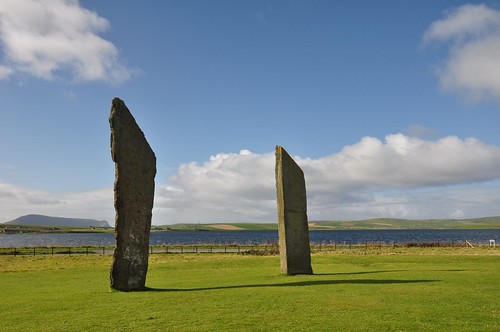
Standing Stones of Stenness
A little further up the road is one of the finest stone circles in the world. The Ring of Brodgar is a stone ring built in a true circle over a 100 metres in diameter. It originally contained sixty megaliths, sadly today only twenty-seven of these stones remain. At least one stone has spectacularly come to grief after being struck by lightening. The ring is part of Orkney's World Heritage Site and has become an iconic part of Orkney's identity. This is the stone ring that Billy Connelly paraded around in his birthday suit during his 'world' tour of Scotland but I had no intention of following his lead.

Ring of Brodgar
After returning to the main road I continued along the loch till I reached the bridge of Waithe and a suitable place for a spot of lunch. After a fine piece of local Orkney tongue on some fresh rolls it was time to complete the last few kilometres into Stromness. Rolling down the hill I was greeted by the ferry terminal that forms part of this old harbour; the harbour provides a natural shelter from the normal flow of Atlantic weather. The flagstone paved main street twists its way through the tightly packed houses that line the shoreline, many of which still have small stone piers, a legacy of the Herring fishing boom now long gone.
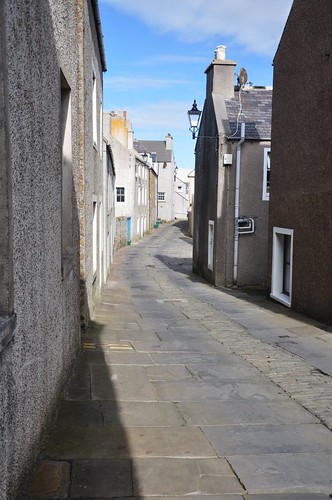
Stromness main street
The campsite is situated at Point of Ness at the mouth of the harbour with views down into Scapa flow and across the sound to Graemsay and Hoy beyond. After setting the tent it was time for a little wander up the coastline toward Warebeth, one of the areas most popular walks.
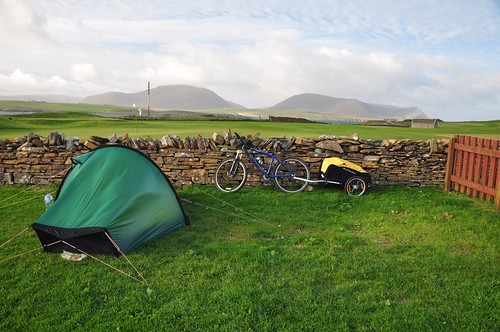
Camp at point of Ness
Although getting late in the year and after many of the summer visitors had left there was still an amazing number and variety of sea birds to see. Seals bobbed about in the swell just offshore with their noses in the air giving the occasional glance to shore to check out passing walkers and their dogs. While enjoying my evening meal back at the tent a feint rumbling brought to my attention the departure of the evening ferry to Scrabster on the Scottish mainland. The ferry Hamnavoe (named after the harbour) and the sound of her engines would become a recognizable feature over the next few days as it made daily sailings out through the sound of Hoy. The wind battered the tent overnight and the movement of the flysheet created a bellows like effect pushing the air around the inside of the tent. The strong wind in the morning dissuaded me from using the bike and so I decided to head back out along the coastal path. Keeping near the coast but crossing some farm fields I made Breckness with its deserted farm buildings. After negotiating a couple of electrified fences I reached Billia Croo and the Oyster wave energy converter test site. From here a more defined path took me up onto the top of Black Craig.
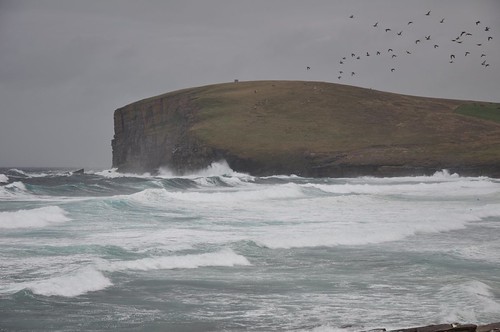
Black Craig
Even on top of the cliffs I was still catching spray from the sea 300 feet below. The weather had roughed up the water and the big swell was battering the base of the cliffs shooting white plumes high into the air. Fulmars and other sea birds were having a lot of trouble retuning to land on their favourite rocky perch's but still showed some amazing flying skills, occasional hovering almost stationary in the air despite the gale force winds. The crashing waves were a reminder of just how forceful the power of the sea can be. Continued erosion along the coast has created a number of caves, natural arches and sea stacks.
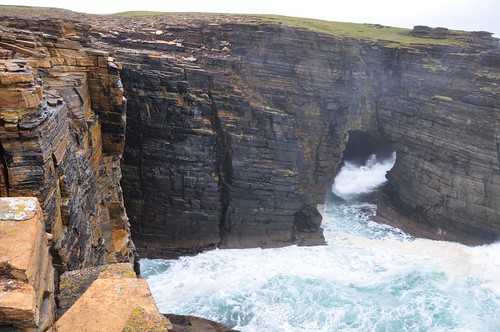
Natural Arch Neban point
The coast is also indented by many Geos, the name given to narrow sea inlets or chasms.
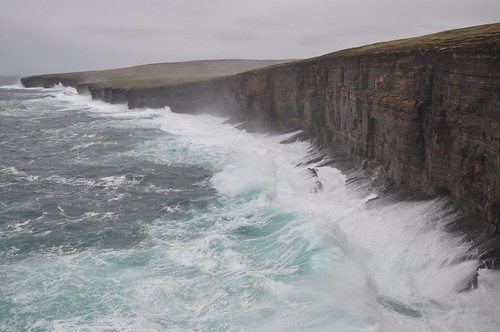
Neban Point
Along from Neban point I came upon the Castle the first sea stack of my holiday. My first impression was that this was quite a broad stack as I viewed it from the south but after moving around the view from the east showed it to be quite a narrow structure, thinning toward its base.

North Gaulton Castle
Further north Yesnaby offered more spectacular scenery of cliffs, stacks and geos. The Castle of Yesnaby is another fine stack and is used by climbers as preparation for more difficult climbs on the Old Man of Hoy. I returned to Stromness by heading inland and then eventually along the main road.
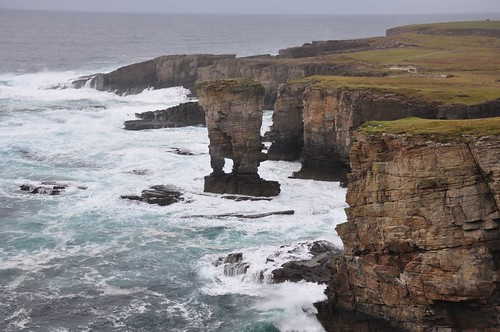
Yesnaby Castle
A grey rainy morning had me enjoying a lazy start to the day, taking time over breakfast and reading my book. Later I took a stroll into town and checked the ferry timetable while down the harbour. The information centre also provided a weather forecast for the next few days, not entirely promising! I decided to make my way over to Hoy and packed the tent in between morning rain showers. The small ferry "Graemsay" took us around the island of the same name riding the heavy swell easily until we went briefly broadside as we turned into the sound of Hoy. After a few heavy rolls we were back on an even keel and soon alongside the key at Moaness at the end of the short 30 minute trip. Some heavy showers were interspersed with some bright sunshine as I made my way to Rackwick, The waters between Hoy and Graemsay were a fine greeny blue when the sun was out. Despite the wind I made good progress and was soon looking down toward Rackwick bay and the high sea cliffs beyond.
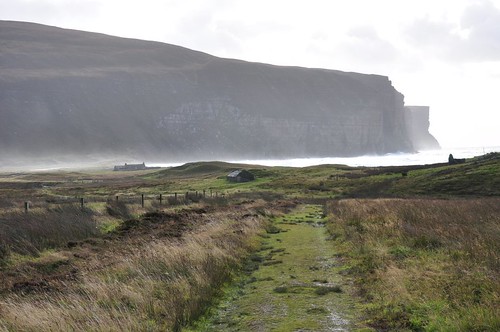
First View of Rackwick Bay
The strong winds were whipping up a healthy swell and the roar of the waves crashing onto the boulder strewn beach added to the wild misty atmosphere of far flung sea spray. An area of grass protected by a dry stone wall next to the bothy was to be my camp for the next couple of nights. After putting up the tent I enjoyed some soup and sandwiches before heading out onto the beach. There was such a contrast to the stones on the beach, some very dark and irregular but plenty very rounded with spheres of colour. The sea spray made it difficult to get a photograph as the camera kept getting covered by the fine salty mist.
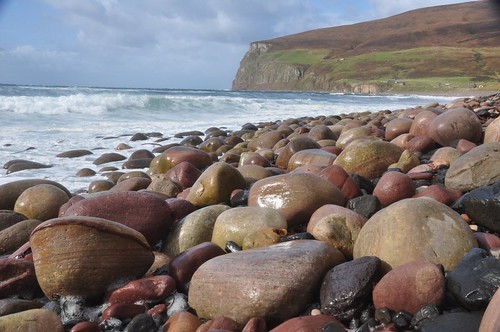
Rackwick Bay
After working along the beach I followed a grassy road up hill and slightly away from the bay to pick up signs for the Old man. A steep track soon had me traversing the heathery hillside and onto what turned out to be a newly completed path that would provide easy access to the famous sea stack. Hopefully over time the path will blend into the surrounds but at present it lies as a broad pink trail across the moor. I dropped off the path for a short while to get a better view of the red cliffs of Rora head.

Rora Head
I was still a couple of kilometres off when I gained my first view of the old man, the upper tiers showing high above the adjacent headland.

The Old Man of Hoy standing tall above the headland
I stopped to chat with a group out on a field exercise, they were on a course dedicated to path building and today they were inspecting the newly laid walkway.
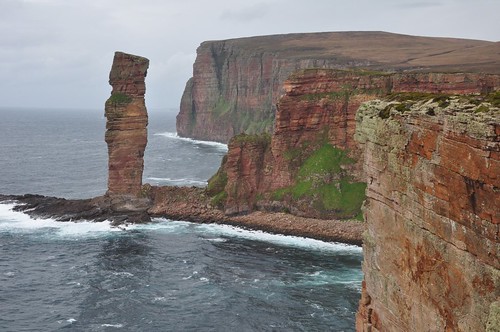
The Old Man Of Hoy
The Old Man of Hoy is certainly a very impressive sight, this huge pillar of red sandstone sits boldly on a bed of volcanic rock somehow able to resist the full fury of the Atlantic storms. At 450 feet the Old man stands proud with his head poking above the surrounding sea cliffs. After enjoying the spectacle I followed the headland as it traced the large promontory onto Rora head. I surprised a couple of Grouse out of the heather while following a feint climbers path as it guided me up a short incline and back onto the newly built tourist path. After continuing a short way around the hillside Rackwick bay came back into view and after joining a vehicle track lower down I ventured back along the beach to the bothy.

Rackwick Bay
A couple of Great Skua's showed some interest in my activities briefly before heading off after a passing Gull. The following day I headed out of the small crofting community to wander down Rackwick Glen. On the outskirts of the settlement an RSPB sign to Moaness indicated the rough but clear path that links Rackwick with the Ferry terminal. The way narrowed in places with the varied plant life encroaching to occasionally knee height. However it wasn't long before I came upon a less defined path that branches off over boggier terrain toward Britain's most northerly native woodland. Berriedale wood with its Birch, Hazel and Honeysuckle is said to be typical of what covered Orkney around 5000BC.

Autumnal Aspen leaf
The wood sits in a sheltered ravine and holds many species of plants otherwise uncommon or extinct in Orkney. After reaching the wood I followed the babbling burn up through the trees to view a series of cascades.
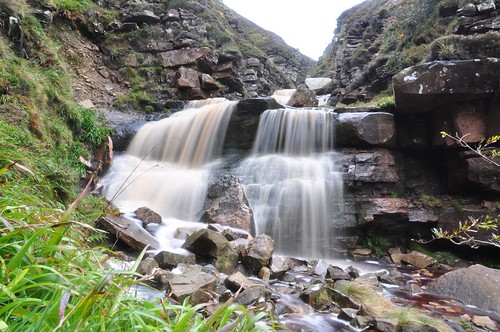
Berriedale Wood cascading burn
There was no further progress to be made from here so I returned downstream until I located a small path that climbed out of the gully giving access to the heathery moor above. This allowed me to follow the burn further up hill and beyond the cascades. The short heather eventually gave out to grasses and bog moss before some broken peaty ground as I gained St Johns head. A number of mountain hare's scurried off into the distance to be concealed from view by the gathering mist. The trig points ringed cairn provided some shelter for a break before I moved seaward to gaze over the precipice of the highest vertical sea cliff in Britain to the waves some 1000 feet below. Picking up the cliff edge path I turned downhill to catch views of the Old man of Hoy.

The Old man from St Johns head
Even this high up I could still taste the sea spray and the mist was creating quite a cold damp atmosphere. I decided to head back over to Berriedale wood out of the wind and below the misty hilltops. My outward paddle was repeated when crossing a swollen burn as I wove my way over to the main path and out of Rackwick glen.
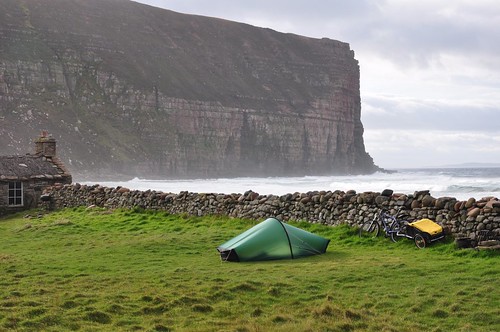
Camp at Rackwick bay
After taking my time over breakfast I did a little beach combing before packing up and heading back toward the ferry terminal.
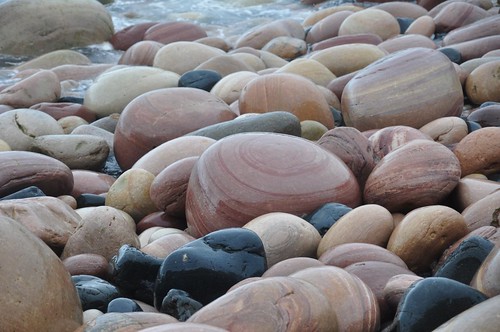
Rackwick bay boulders
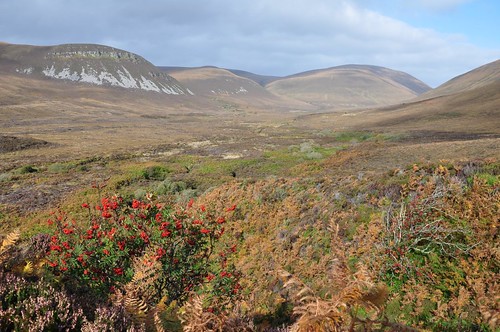
Rowan tree in Rackwick Glen
There was some impressive Lenticular clouds above Dwarfie Hamars as I parked the bike and took the footpath and wooden trestles across to the Dwarfie Stane, the only rock-cut tomb in Britain, thought to date back to 3000BC. According to Sir Walter Scott it was the residence of the 'Trolld', a legendary Norse dwarf. The stone features some interesting Victorian graffiti including Latin and Persian lettering.

Dwarfie Stane
It was at the stone that I met up with Diane, over from California to sample the delights of the Highlands and the Orkney Isles. We chatted a while before taking the short walk back to the main road at which point I headed off on my bike to visit Sandy Loch while Diane began the walk down to the Ferry. The last section of the road up to the loch was directly against the wind and really hard work. Sandy loch lies at the foot of Ward hill which at 479m is the highest point in Orkney. Great Skua's are known to come to this freshwater loch to take a bath and wash the salt out of their feathers. With the wind directly at my back I was soon picking up speed as I headed for Moaness and required constant use of my brakes as the way dipped toward the bay of Creekland and the pier. The rough seas delayed the ferries arrival and provided for another choppy ride on our way back to Stromness. Diane kindly helped me to get my trailer up the ferry and pier steps and onto the quay before we decided to sample a pint of the local beer at the Ferry Inn. The talk eventually turned to food and I started to look forward to the possibility of a fish supper so we agreed to meet later for a visit to the chip shop. Back at the point of Ness camp site I quickly had the tent back up before enjoying a refreshing shower. Diane met me at the site and we took the short walk back into town. Checking the menu the idea of a curry quickly won over the day although we had to settle for beef after finding out there was none of the preferred lamb left. An enjoyable evening was spent and toasted with a drop of what is probably my favourite whisky, Talisker from the Isle of Skye. Diane was back off toward Inverness the following day and I just about managed to pick her out on deck as the morning ferry sailed past on the way to Scrabster.
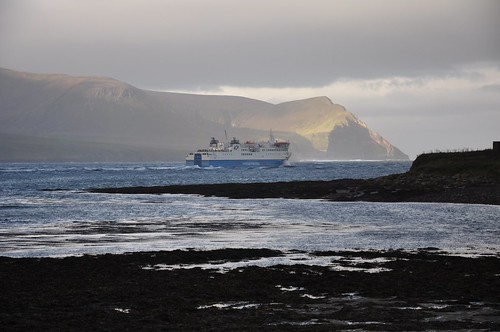
Morning Ferry heading past Hoy
I picked up some sandwiches and a bit of shopping while in town before packing a bag in preparation for a trip up the coast. Saturday seemed to be one of few days that the bus went directly up the coast past Skara Brae and onto to Birsay. I alighted at Marwick and headed down to the beach before taking a short detour south to view some recently restored fishermen's huts. I then started northward following the shore path around the bay and up onto Marwick head. Nearing the top a realised I had dropped one of my water bottles so leaving my rucksack I headed back down in search, finding it of course at the bottom and a short way back along the beach path. The impressive cliffs of Marwick Head are topped by the impressive Kitchener memorial. Stone-built to commemorate the loss of HMS Hampshire, which sank here in mysterious circumstances with the loss of all but 12 men, including Lord Kitchener, the then minister of Minister of War. This is a apparently a great spot for bird watching during the breeding months and the best place in the mainland for sighting puffins, unfortunately long since gone before my arrival.

Marwick Head
As I continued on my way to Birsay the short grasses along the headland provided for very pleasant walking especially as the sun had decided to come out and brighten the day.
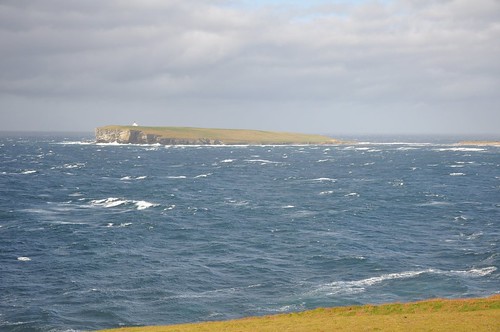
Birsay across the bay
The Brough of Birsay is a tidal island reached by a narrow causeway for only a couple of hours either side of low tide only. The island has the remains of both Pictish and Norse settlements, including St. Peter's Kirk. The tide was still too high for me to venture across and I would need to head off to catch the bus before it dropped low enough for a crossing. Not sure if the bus came down to the Palace at Birsay I headed up to catch it at the crossroads only be driven back down into Birsay. Some fine manoeuvring by the driver soon had the bus turned around in the dead end road near the remains of the Palace. A couple got off here leaving me as the only passenger for the return to Stromness. There was a blues festival on over the weekend so after cleaning up and eventually satisfying my craving for fish and chips I had a couple of pints whiles enjoying a fine rhythm and blues band playing at the Stromness hotel. The wind would eventually drop during my final two days on the Islands only to be replaced by fairly persistent rain. Sunday morning was another leisurely breakfast with multiple cups of tea and the opportunity to continue with my book. Donning my waterproofs I ventured out for a final walk along the coast before heading into town. At the harbour one of the fishing boats was unloading a fine haul of large crabs. Most of the diving boats which ply their trade in the waters of Scapa flow seemed to be in port at this, I suppose, the tail end of the season. Not too many places were open but Julia's café and bistro was doing brisk trade. I escaped the rain and decided to try what turned out to be a fine fisheremans pie. Monday was time to head back over to Kirkwall but there was no real rush as my ferry wasn't until late evening. I took the southern coast road stopping a couple of times taking advantage of occasional breaks in the rain. At Scapa bay near the harbour pier there was a number of seabirds feeding, some young Gannets continually circled and plunged into the waters in the quest for food while sharpening their fishing skills. A seal bobbed in between the army of feathered bodies providing a bit of competition in the search for fish. First port of call in Kirkwall was the tea shop for a hot drink and the chance to dry out a bit. Kirkwall Cathedral provided me with my final bit of sightseeing on what had been a very enjoyable first trip to Orkney.

Kirkwall Cathedral
All that remained was to catch the overnight ferry that would see me back in Aberdeen in time for breakfast and a chance to clean up before heading into work. I had a nice surprise upon boarding the ferry as I bumped into Isla and her friend who had been on a quick cycle tour of Orkney over a long weekend. Isla and I cross paths most mornings as we cycle in opposite directions on our way to work and usually only manage a quick hi and a wave so it was nice to have a little more of a chat.
Top Of Page
site info
© 2007-2008 Paul Sammonds. Template Design by Andreas Viklund.